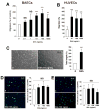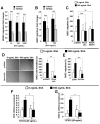Sonic hedgehog induces angiogenesis via Rho kinase-dependent signaling in endothelial cells
- PMID: 20478312
- PMCID: PMC2917529
- DOI: 10.1016/j.yjmcc.2010.05.003
Sonic hedgehog induces angiogenesis via Rho kinase-dependent signaling in endothelial cells
Abstract
The morphogen Sonic hedgehog (Shh) promotes neovascularization in adults by inducing pro-angiogenic cytokine expression in fibroblasts; however, the direct effects of Shh on endothelial cell (EC) function during angiogenesis are unknown. Our findings indicate that Shh promotes capillary morphogenesis (tube length on Matrigel increased to 271+/-50% of the length in untreated cells, p=0.00003), induces EC migration (modified Boyden chamber assay, 191+/-35% of migration in untreated cells, p=0.00009), and increases EC expression of matrix metalloproteinase 9 (MMP-9) and osteopontin (OPN) mRNA (real-time RT-PCR), which are essential for Shh-induced angiogenesis both in vitro and in vivo. Shh activity in ECs is mediated by Rho, rather than through the "classic" Shh signaling pathway, which involves the Gli transcription factors. The Rho dependence of Shh-induced EC angiogenic activity was documented both in vitro, with dominant-negative RhoA and Rho kinase (ROCK) constructs, and in vivo, with the ROCK inhibitor Y27632 in the mouse corneal angiogenesis model. Finally, experiments performed in MMP-9- and OPN-knockout mice confirmed the roles of the ROCK downstream targets MMP-9 and OPN in Shh-induced angiogenesis. Collectively, our results identify a "nonclassical" pathway by which Shh directly modulates EC phenotype and angiogenic activity.
Copyright 2010 Elsevier Ltd. All rights reserved.
Figures






Similar articles
-
Microparticles harboring Sonic Hedgehog promote angiogenesis through the upregulation of adhesion proteins and proangiogenic factors.Carcinogenesis. 2009 Apr;30(4):580-8. doi: 10.1093/carcin/bgp030. Epub 2009 Jan 23. Carcinogenesis. 2009. PMID: 19168578
-
The Hedgehog transcription factor Gli3 modulates angiogenesis.Circ Res. 2009 Oct 9;105(8):818-26. doi: 10.1161/CIRCRESAHA.109.206706. Epub 2009 Sep 3. Circ Res. 2009. PMID: 19729595 Free PMC article.
-
RhoA/ROCK signaling is essential for multiple aspects of VEGF-mediated angiogenesis.FASEB J. 2010 Sep;24(9):3186-95. doi: 10.1096/fj.09-145102. Epub 2010 Apr 16. FASEB J. 2010. PMID: 20400538 Free PMC article.
-
Sonic hedgehog derived from human pancreatic cancer cells augments angiogenic function of endothelial progenitor cells.Cancer Sci. 2008 Jun;99(6):1131-8. doi: 10.1111/j.1349-7006.2008.00795.x. Epub 2008 Apr 14. Cancer Sci. 2008. PMID: 18422746 Free PMC article.
-
Endothelial smoothened-dependent hedgehog signaling is not required for sonic hedgehog induced angiogenesis or ischemic tissue repair.Lab Invest. 2018 May;98(5):682-691. doi: 10.1038/s41374-018-0028-5. Epub 2018 Feb 16. Lab Invest. 2018. PMID: 29453401 Free PMC article.
Cited by
-
Applications of Matrix Metalloproteinase-9-Related Nanomedicines in Tumors and Vascular Diseases.Pharmaceutics. 2025 Apr 7;17(4):479. doi: 10.3390/pharmaceutics17040479. Pharmaceutics. 2025. PMID: 40284474 Free PMC article. Review.
-
Extracellular vesicles as therapeutic tools in cardiovascular diseases.Front Immunol. 2014 Aug 4;5:370. doi: 10.3389/fimmu.2014.00370. eCollection 2014. Front Immunol. 2014. PMID: 25136343 Free PMC article. Review.
-
Placental Angiogenesis in Mammals: A Review of the Regulatory Effects of Signaling Pathways and Functional Nutrients.Adv Nutr. 2021 Dec 1;12(6):2415-2434. doi: 10.1093/advances/nmab070. Adv Nutr. 2021. PMID: 34167152 Free PMC article. Review.
-
Multivalent Conjugates of Sonic Hedgehog Accelerate Diabetic Wound Healing.Tissue Eng Part A. 2015 Sep;21(17-18):2366-78. doi: 10.1089/ten.TEA.2014.0281. Tissue Eng Part A. 2015. PMID: 26154888 Free PMC article.
-
Cilia interactome with predicted protein-protein interactions reveals connections to Alzheimer's disease, aging and other neuropsychiatric processes.Sci Rep. 2020 Sep 24;10(1):15629. doi: 10.1038/s41598-020-72024-4. Sci Rep. 2020. PMID: 32973177 Free PMC article.
References
-
- Bitgood MJ, Shen L, McMahon AP. Sertoli cell signaling by Desert hedgehog regulates the male germline. Curr Biol. 1996;6:298–304. - PubMed
-
- Chiang C, Litingtung Y, Lee E, Young KE, Corden JL, Westphal H, et al. Cyclopia and defective axial patterning in mice lacking Sonic hedgehog gene function. Nature. 1996;383:407–13. - PubMed
-
- Johnson RL, Tabin CJ. Molecular models for vertebrate limb development. Cell. 1997;90:979–90. - PubMed
-
- Parmantier E, Lynn B, Lawson D, Turmaine M, Namini SS, Chakrabarti L, et al. Schwann cell-derived Desert hedgehog controls the development of peripheral nerve sheaths. Neuron. 1999;23:713–24. - PubMed
-
- Pepicelli CV, Lewis PM, McMahon AP. Sonic hedgehog regulates branching morphogenesis in the mammalian lung. Curr Biol. 1998;8:1083–6. - PubMed
Publication types
MeSH terms
Substances
Grants and funding
LinkOut - more resources
Full Text Sources
Other Literature Sources
Research Materials
Miscellaneous

